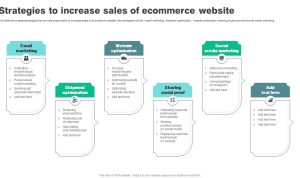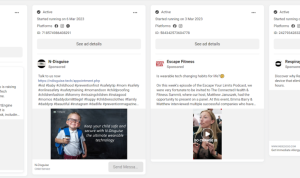Delving into The Role of Augmented Reality in Online Shopping, we find ourselves at the intersection of technology and consumer experience, where innovative solutions are redefining the retail landscape. As more shoppers gravitate towards online platforms, augmented reality (AR) emerges as a game-changing tool, allowing consumers to visualize products in their own environment before making a purchase. This blend of virtual and physical worlds not only enhances the shopping experience but also invites a wave of new trends aimed at improving customer engagement and satisfaction.
Augmented reality is revolutionizing how we shop online by bridging the gap between digital and physical interactions. From virtual fitting rooms to interactive furniture previews, AR technology offers a dynamic solution to common online shopping challenges, making it easier for customers to make informed decisions. With the rapid growth of AR in retail, it’s clear that this technology is not just a passing trend but a significant player in shaping the future of e-commerce.
Introduction to Augmented Reality in Online Shopping
Augmented Reality (AR) is a cutting-edge technology that superimposes digital information onto the real world, enhancing the user’s perception and interaction with their environment. In the realm of online shopping, AR plays a crucial role by bridging the gap between the virtual and physical shopping experiences. As consumers increasingly turn to online platforms, AR enhances product visualization, allowing customers to see how items will look and fit in their own space before making a purchase.The integration of AR in online shopping transforms the way consumers engage with products.
By providing interactive and immersive experiences, AR allows shoppers to visualize items in a realistic context, which improves confidence in purchase decisions. For instance, furniture retailers like IKEA use AR to let customers place virtual furniture in their homes through smartphones or tablets, making it easier for them to envision how a piece fits into their existing décor. This innovative application not only enhances user experience but also drives sales by reducing the uncertainty often associated with online purchases.
Growth and Trends of Augmented Reality Technology in Retail
The growth of AR technology in the retail sector is notable, fueled by advancements in smartphone capabilities and increasing consumer demand for seamless shopping experiences. Retailers are recognizing the potential of AR to enhance customer engagement and satisfaction.
In recent years, several trends have emerged in the use of AR within retail
Increased Adoption
More retailers are incorporating AR into their websites and apps, ranging from cosmetics brands that allow virtual try-ons to fashion retailers showcasing how clothing fits on virtual models.
Enhanced Personalization
AR allows for a more personalized shopping experience, as customers can customize products and visualize them in real-time.
Social Media Integration
Platforms like Instagram and Snapchat are adopting AR filters, allowing brands to reach a wider audience and engage customers in interactive marketing campaigns.
Data-Driven Insights
Retailers are leveraging data collected from AR interactions to better understand consumer behavior, informing inventory management, product development, and marketing strategies.In summary, AR technology is not just a passing trend; it’s becoming an integral part of the online shopping landscape. As retailers continue to innovate and adapt to consumer preferences, AR is likely to play an increasingly significant role in shaping the future of retail.
Benefits of Augmented Reality for Consumers
Augmented Reality (AR) has emerged as a transformative tool in online shopping, providing a rich and engaging experience that enhances consumer interaction with products. By leveraging AR technology, retailers can create a more immersive shopping environment, which not only captivates consumers but also addresses some of the challenges associated with traditional online shopping.AR improves product visualization, allowing consumers to interact with items in a virtual space that mimics real life.
This technology bridges the gap between the online shopping experience and physical retail, enabling buyers to visualize products in their intended environment. Customers can see how a piece of furniture fits in their living room or how a pair of shoes looks on their feet, leading to more informed purchasing decisions.
Enhanced Product Visualization
The ability to visualize products in a real-world context is a significant advantage of AR in online shopping. Customers benefit from getting a true sense of scale, color, and design as they can overlay digital images of products onto their actual surroundings. This function is crucial in sectors like home décor and fashion, where the physical properties of products heavily influence buying decisions.
The following points Artikel how AR enhances product visualization for consumers:
- Real-time Interaction: Consumers can manipulate virtual representations of products, such as rotating or resizing them, to better understand how they would fit into their lives.
- Contextual Placement: By projecting products into real-world settings, shoppers can assess how items look in their homes or with their existing wardrobe.
- Immediate Feedback: Instant visual feedback helps consumers make quicker decisions, reducing the time spent deliberating over purchases.
Reduction of Return Rates
One of the most significant benefits of AR in online shopping is its potential to lower return rates. A common issue in e-commerce is the discrepancy between consumer expectations and the actual product received. AR addresses this challenge by providing a more accurate representation of products before purchase, which leads to higher satisfaction.The following factors contribute to the reduction of return rates through AR:
- Informed Decisions: By visualizing products accurately in their environment, consumers are less likely to experience buyer’s remorse.
- Expectation Management: AR helps set realistic expectations regarding product dimensions, colors, and overall aesthetics, minimizing the chances of disappointment upon delivery.
- Enhanced Confidence: Shoppers feel more confident in their purchases when they can see how items will fit or complement their existing belongings, leading to fewer returns.
“By integrating Augmented Reality into the shopping experience, retailers can enhance customer satisfaction and significantly reduce product return rates.”
Implementation of Augmented Reality in E-commerce Platforms: The Role Of Augmented Reality In Online Shopping
The integration of augmented reality (AR) into e-commerce platforms has revolutionized the online shopping experience. This technology allows consumers to visualize products in their own environments, fostering a deeper connection and enhancing the decision-making process. By leveraging AR, online retailers can create immersive shopping experiences that bridge the gap between physical and digital interactions.The successful implementation of AR in e-commerce involves several key technologies and tools.
These include 3D modeling software, AR development frameworks, and mobile applications that require robust back-end integration. Here are some essential components that play a vital role in the deployment of AR features on e-commerce websites:
Technologies and Tools for Augmented Reality
To effectively execute augmented reality in online stores, a combination of technologies needs to be utilized. Each element serves a specific function in delivering an engaging AR experience for consumers. The following technologies and tools are crucial:
- 3D Modeling Software: Tools like Blender and Autodesk Maya are essential for creating detailed 3D models of products that can be rendered in AR.
- AR Development Frameworks: Platforms such as ARKit (for iOS), ARCore (for Android), and Vuforia enable developers to build AR applications that can recognize and interact with the real world.
- Web-based AR Solutions: Technologies like WebAR allow AR experiences to be accessed directly through a web browser, removing the need for app downloads.
- Content Management Systems (CMS): Integrating AR features requires a CMS that supports multimedia content, such as Shopify or WordPress with AR plugins.
The integration of these tools helps streamline the process of developing AR functionalities, ensuring that retailers can provide an engaging experience to their customers.
Step-by-Step Guide to Integrating Augmented Reality Features
Implementing augmented reality into an e-commerce platform is a structured process. Here’s a step-by-step guide to assist retailers in this transition:
1. Identify Objectives Define what you aim to achieve with AR, such as increasing customer engagement or reducing return rates.
2. Select Appropriate Tools Choose the right technology stack based on your platform’s needs and the development resources available.
3. Create 3D Models Use 3D modeling software to design realistic representations of your products.
4. Develop AR Experience Utilize AR development frameworks to code the functionality, ensuring that the AR experience is intuitive and user-friendly.
5. Test the Implementation Conduct thorough testing to identify any bugs or usability issues before launching the AR feature.
6. Launch and Promote Introduce the AR functionality to your customers through marketing campaigns, highlighting its benefits.
7. Gather Feedback After launch, collect user feedback to refine and improve the AR experience continuously.This systematic approach ensures that retailers can effectively harness the power of AR, leading to enhanced consumer satisfaction and increased sales.
Successful E-commerce Brands Utilizing Augmented Reality
Several leading e-commerce brands have already embraced augmented reality, setting a precedent for others in the industry. These companies demonstrate the potential of AR to enrich the online shopping experience:
- IKEA: The IKEA Place app allows customers to visualize furniture in their own homes, helping them make informed purchasing decisions.
- Sephora: Sephora’s Virtual Artist enables users to try on makeup virtually, increasing customer confidence in beauty product purchases.
- Amazon: The Amazon app includes a “View in Your Room” feature, allowing customers to see how products would look in their actual living spaces.
- Nike: Nike’s app offers a “Try-On” feature that lets customers visualize how shoes will fit and look on their feet before buying.
These examples highlight how AR can significantly enhance product visualization and customer engagement, leading to higher conversion rates and customer loyalty in the digital marketplace.
Challenges and Limitations of Augmented Reality in Online Shopping
The integration of augmented reality (AR) into online shopping presents exciting opportunities, yet it is not without its challenges. Retailers face numerous hurdles when attempting to implement AR technology, which can hinder its effectiveness and limit consumer adoption. Understanding these obstacles is essential for both businesses looking to enhance their shopping experience and consumers seeking to navigate this evolving landscape.One significant challenge retailers face is the cost associated with developing and maintaining AR applications.
This technology requires substantial investment in software development, hardware compatibility, and ongoing updates to stay relevant. Furthermore, retailers must ensure that their AR solutions are user-friendly and accessible across various devices, which can complicate the development process.
Technical Limitations of Augmented Reality
The technical limitations of AR in online shopping impact the overall user experience and effectiveness of the technology. Key issues include:
- Device Compatibility: Not all smartphones or tablets are equipped with the necessary hardware to support high-quality AR applications. This can lead to a fragmented experience where only some users can access the full functionality of the AR features.
- Internet Connectivity: AR applications often require stable and high-speed internet connections to function optimally. Poor connectivity can lead to lagging or glitchy experiences, which can frustrate users and deter them from using AR features.
- Realism and Accuracy: Achieving a realistic representation of products in AR is crucial for consumer confidence. However, limitations in rendering technology can result in inaccurate or poorly scaled models, which may not reflect the actual products.
- Integration with Existing Systems: Retailers must integrate AR solutions with their current e-commerce platforms and inventory management systems. This can be complex and may require significant resources to ensure a seamless experience.
Consumer Resistance to Augmented Reality
Consumer resistance to adopting AR in their shopping habits is another barrier that retailers must navigate. Several factors contribute to this reluctance:
- Lack of Awareness: Many consumers are still unfamiliar with AR technology and its benefits, which can lead to skepticism regarding its usefulness in enhancing their shopping experience.
- Privacy Concerns: With increased use of mobile cameras and location tracking, consumers may have concerns about their privacy and data security when utilizing AR features.
- Preference for Traditional Shopping: Some consumers prefer the tactile experience of shopping in-store, where they can physically examine products before making a purchase. This preference can make them hesitant to embrace AR as a viable alternative.
- Learning Curve: The introduction of new technology often requires a learning period, and consumers may be unwilling to invest the time and effort necessary to understand and use AR applications effectively.
Future of Augmented Reality in Retail
The future of augmented reality (AR) in retail is poised for remarkable transformation as technology continues to advance. With an increasing number of consumers turning to online shopping, the integration of AR offers a unique opportunity to enhance user experiences, making the digital shopping environment more immersive and interactive. This evolution will likely redefine both consumer behavior and retail strategies, leading to a more personalized and engaging shopping experience.As AR technology becomes more sophisticated, we can anticipate several key trends that will shape the future of online shopping.
One of the most notable advancements is the development of AR-enabled devices that provide seamless integration of virtual elements into the real world. This can include everything from smart glasses that overlay product information to mobile applications that utilize advanced computer vision to enhance interactions. The following points Artikel potential advancements and their implications for the retail landscape:
Emerging Trends in Augmented Reality
As retailers embrace augmented reality, several trends are expected to gain traction:
- Personalized Shopping Experiences: Advanced algorithms will enable AR applications to curate personalized shopping experiences based on individual preferences, browsing history, and real-time feedback. This could result in tailored product recommendations that resonate with consumers.
- Virtual Try-Ons: Virtual fitting rooms are likely to become commonplace, allowing consumers to try on clothing, accessories, or even makeup digitally. This functionality can significantly reduce return rates and improve customer satisfaction.
- Enhanced Product Visualization: Retailers will increasingly use AR to provide 3D visualizations of products in real-world contexts. For example, furniture retailers may allow customers to visualize how a piece of furniture would look in their home before making a purchase.
- Social Shopping Integration: The future of AR may see further integration with social media platforms, enabling users to share their shopping experiences and virtual try-ons with friends. This social aspect can foster community engagement and drive sales through shared recommendations.
- Gamification of Shopping: Retailers might incorporate gamification elements into their AR experiences, turning shopping into a more interactive and enjoyable game-like experience. This could include AR treasure hunts or rewards systems for interacting with products.
As augmented reality continues to evolve, the technology will likely reshape consumer behavior and retail strategies. Retailers who adopt AR technology will have a competitive edge by creating engaging and memorable shopping experiences that resonate with consumers’ desires for convenience and personalization.
AR is not just a tool for visualization; it’s a transformative technology that can redefine how consumers interact with brands and products.
In summary, the future of augmented reality in retail holds significant promise, with technological advancements leading to immersive shopping experiences that align closely with modern consumer expectations. As the technology matures, it will pave the way for innovative retail strategies that prioritize user engagement and satisfaction, ultimately reshaping the landscape of online shopping.
Case Studies of Augmented Reality in Action
Augmented Reality (AR) is reshaping online shopping by providing immersive experiences that enhance consumer engagement. Numerous companies have successfully integrated AR into their e-commerce platforms, showcasing innovative approaches that significantly impact their sales and customer interactions. This section presents detailed examples of companies employing AR, analyzes their effectiveness, and compares their methodologies.
IKEA Place
IKEA’s AR app, IKEA Place, allows customers to visualize furniture in their own homes before making a purchase. By using their smartphone cameras, users can place true-to-scale 3D models of IKEA products in their living spaces. This practical application addresses common consumer concerns about fit and style, leading to greater confidence in purchasing decisions. The impact of IKEA Place on consumer engagement is evident through increased interaction time within the app, with users spending an average of 30 minutes exploring options.
Furthermore, reports indicate a 20% increase in sales among users of the app compared to those who did not use it.
Sephora Virtual Artist
Sephora’s Virtual Artist app employs AR technology to let consumers try on makeup virtually. Users can experiment with different shades of lipstick, eyeshadow, and other products through their devices’ cameras. This interactive feature not only enhances the shopping experience but also helps customers make informed choices, minimizing the likelihood of returns.The introduction of the Virtual Artist has shown significant results, including a 200% increase in mobile conversion rates.
By facilitating a more personalized shopping experience, Sephora has effectively increased customer loyalty and engagement.
Warby Parker’s Virtual Try-On
Warby Parker has implemented an AR feature in its mobile app that enables customers to virtually try on glasses. Using facial recognition technology, the app allows users to see how different frames look on their faces. This seamless integration of AR into the shopping process has driven customer satisfaction and reduced the uncertainty often associated with purchasing eyewear online.The results speak for themselves, with Warby Parker reporting a 20% increase in sales attributed to the virtual try-on feature.
Customers feel more empowered to make decisions, which translates into higher conversion rates.
Converse’s Sampler
Converse has developed an AR feature called Sampler that lets customers customize their shoes in real-time. Through the app, users can change colors, patterns, and styles, allowing for a unique shopping experience. This personalization aspect not only engages consumers but also fosters a sense of ownership over the product.The success of Sampler is reflected in the increased engagement rates on Converse’s platform.
Users are spending more time designing their shoes, which has led to a measurable uptick in sales of customized products.
Comparative Analysis of AR Implementations
The case studies of IKEA, Sephora, Warby Parker, and Converse illustrate varying strategies in deploying AR technology. While IKEA focuses on spatial visualization, Sephora and Warby Parker emphasize personalization through virtual try-ons. Converse leverages customization, allowing users to engage creatively with products.These approaches highlight the flexibility of AR in addressing unique consumer needs across different sectors. Despite the differences, a common theme emerges: AR enhances customer engagement, leading to improved sales performance and customer satisfaction.
User Experience and Interaction with Augmented Reality

The integration of augmented reality (AR) in online shopping platforms significantly transforms user interaction, creating a more immersive and engaging experience for consumers. AR enables shoppers to visualize products in their own environment, bridging the gap between online and in-store shopping experiences. This technology not only enhances product presentation but also elevates user satisfaction by allowing personalized interactions with items before making a purchase.The incorporation of augmented reality into e-commerce sites streamlines the shopping process, providing users with real-time, interactive experiences that cater to their preferences.
By allowing customers to see how a product looks in their space or on themselves, AR fosters a more confident decision-making process. Customers are more likely to engage deeply with a product when they can interact with it firsthand, thus reducing uncertainty and increasing conversion rates.
Best Practices for Designing User-Friendly Augmented Reality Applications
Creating user-friendly AR applications requires careful consideration of design elements that enhance usability and accessibility. Here are key practices to ensure a positive user experience:
- Simplicity in Design: Keep the interface uncluttered to ensure that users can easily navigate through options without distraction.
- Intuitive Controls: Utilize familiar gestures and controls that users can easily understand, such as pinch-to-zoom or swipe actions.
- High-Quality Graphics: Ensure that virtual products are rendered in high resolution to provide a realistic and appealing appearance.
- Feedback Mechanisms: Implement visual or auditory feedback when users interact with AR elements to enhance engagement.
- Mobile Optimization: Design AR experiences that are optimized for mobile devices since a significant portion of online shopping occurs on smartphones.
- Clear Instructions: Provide concise instructions or prompts on how to use AR features to eliminate confusion for first-time users.
- Accessibility Features: Incorporate features that cater to users with different abilities, ensuring an inclusive shopping experience for all.
Understanding consumer feedback regarding augmented reality features in online shopping is essential to enhance the user experience. Many consumers appreciate the ability to visualize products before purchase, often mentioning how AR has reduced return rates by providing clearer expectations. Additionally, users frequently express satisfaction with the interactive nature of AR apps, as they feel more engaged in the shopping experience.
However, some feedback highlights the importance of AR features loading quickly and performing seamlessly, as any lag can frustrate users and diminish their overall experience.
“Augmented reality transforms the online shopping journey, making it more interactive and personal, leading to higher satisfaction and reduced uncertainty.”
The Role of Augmented Reality in Marketing Strategies
Augmented Reality (AR) has emerged as a game-changer in the marketing landscape, enabling brands to create immersive experiences that captivate consumers. By integrating AR into their marketing campaigns, companies can enhance brand engagement, improve customer interaction, and ultimately drive sales. The ability to allow consumers to visualize products in their own environment before making a purchase is a powerful tool for modern marketers.Brands can seamlessly integrate augmented reality into their marketing strategies in several ways.
Innovative use of AR can transform traditional advertising into interactive experiences that resonate more deeply with audiences. This integration can be achieved through mobile applications, AR-enabled advertisements, and in-store experiences. For instance, a furniture retailer may employ AR to allow customers to visualize how a specific piece of furniture looks in their living room through a mobile app, significantly enhancing the pre-purchase experience.
Successful Marketing Examples of Augmented Reality, The Role of Augmented Reality in Online Shopping
The effectiveness of AR in marketing can be seen through various successful campaigns that have leveraged this technology to attract and engage customers. These examples highlight the versatility and impact of AR in different sectors.
1. IKEA Place
This mobile app allows users to visualize furniture in their homes using AR technology. Customers can select items from the IKEA catalog and see how they fit into their space, which boosts confidence in purchasing decisions.
2. L’Oreal Makeup Genius
This app enables users to try on different makeup products virtually. Users can see how different shades and styles look on their own faces in real time, making the shopping experience more personal and enjoyable.
3. Sephora Virtual Artist
By integrating AR into its mobile application, Sephora allows customers to virtually try on makeup products. This approach not only enhances customer engagement but also reduces return rates due to better pre-purchase visualization.
4. Pepsi Max Augmented Reality Bus Shelter
In a unique marketing stunt, Pepsi Max transformed a bus shelter into an AR experience that allowed waiting passengers to see virtual monsters and other surprising elements on the street. This campaign generated significant buzz and engagement across social media platforms.The impact of these campaigns can be measured using key performance indicators unique to augmented reality marketing.
Metrics for Measuring Effectiveness of Augmented Reality in Marketing
To gauge the effectiveness of AR marketing strategies, brands can track specific metrics that provide insights into user engagement, conversion rates, and overall campaign success. Below is a table summarizing these key metrics.
| Metric | Description |
|---|---|
| Engagement Rate | Measures user interaction with AR content, such as time spent using the AR feature and the number of times it is accessed. |
| Conversion Rate | Tracks the percentage of users who make a purchase after using AR features, indicating effectiveness in driving sales. |
| Customer Retention | Assesses how many users return to use AR features again, reflecting ongoing interest and satisfaction with the brand. |
| Social Shares | Counts the number of times users share AR content on social media, providing insight into virality and brand reach. |
| Feedback and Reviews | Analyzes customer feedback on AR experiences through surveys and reviews, helping to refine future AR strategies. |
By leveraging these metrics, brands can gain a comprehensive understanding of how augmented reality influences consumer behavior and refine their marketing strategies accordingly. The integration of AR not only enhances marketing efforts but also fosters a deeper connection between brands and their audiences.





